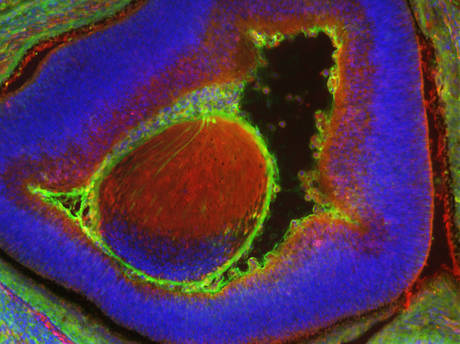A mouse embryo has been used as a 'biofactory' to produce millions of mature human stem cells, including red blood cells. The technique, published in the Science Advances journal by the University of Buffalo group led by Jian Feng, solves a problem that had hitherto prevented producing these cells in vivo in sufficient quantities within a living organism, and at the time itself will help build more reliable models for the study of many diseases, such as Covid-19 and malaria, and to revolutionize stem cell-based therapies.
For decades, the enormous potential of human stem cells has been held back by the inability to produce enough of them in vivo in a living organism. A problem that could now be solved thanks to this new method, with which the researchers generated millions of human cells in the mouse embryo in 17 days, including red blood cells, eye and liver cells.
In green cells of the human eye in a 17-day mouse embryo (in blue) (source: Zhixing Hu)
Up to now only small quantities of immature cells have been obtained, difficult to quantify. "In this study the mouse embryo was used as a 'biofactory' to produce blood components. An interesting, but still experimental and early result, which needs to be investigated", comments Carlo Alberto Redi, director of the Laboratory of Developmental Biology of the University of Pavia.
Being able to produce human cells in vivo is important because those made in the laboratory do not behave the same way. "This research allows us to use the mouse embryo to better understand human development," comments Feng. Continuing on this path, "there could be an even greater production of specific types of mature human cells, to obtain - he observes - more effective models of mice for studying diseases affecting humans, such as malaria or Covid-19" .
And since so many mature cells can be produced with this method, it could also be used to generate materials to treat chronic diseases, such as diabetes or kidney failure, by replacing the patient's damaged cells with human cells or healthy tissues. According to Feng, components of the human respiratory system could also be created to study Covid-19, which affects humans but not mice, or perhaps to produce mice with red cells that are even more mature for those diseases that affect these types of humans in humans. cells.
This new technique has made it possible to overcome another problem, namely that of converting pluripotent human stem cells, which can differentiate into all types of cells in the body, in a form compatible with a 3-day mouse embryo, where often the human cells fail to develop. "There are still many questions to be answered before this technology can become useful - continues Feng - but this is the first time that so many mature human cells have been generated in a mouse embryo".

